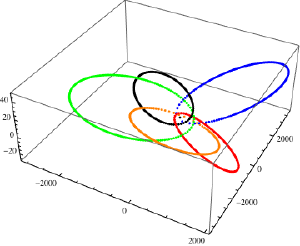Post
Massive Evidence
10 July 2012
The center of our galaxy is about 27,000 light years away in the direction of the constellation Sagittarius. That isn’t a large distance on astronomical scales, but it is hidden by gas and dust so we can’t observe it in visible light. We can, however, observe it at infrared and radio wavelengths, and what we see is very interesting.
Over the past 20 years we’ve been able to individual infrared sources orbiting the galactic center. We now know these infrared sources are individual stars. Very near the center there is a cluster of about 100 stars known as the S-cluster. We’ve been able to determine their orbits, and they tell us something about the mass in the center of our galaxy.
 Brian Koberlein
Brian KoberleinIn the figure I’ve plotted the orbits of the five closest S-cluster stars. They have orbital periods ranging from 15 to 47 years. You can see that their orbits appear to be ellipses. This is just what you would expect if the central mass is very small (in size, not mass), and it means we can use Kepler’s laws of motion to determine the central mass.
Kepler’s third law says that if you take the cube of the semimajor axis (a measure of the size of the ellipse) and divide it by the square of its orbital period (how long it takes to complete one orbit), then you always get the same constant. If the semimajor axis is measured in AU and the period in years, then that constant is the mass of the central object.
Since we have determined the orbits of about 100 stars, we can calculate the central mass pretty accurately. What we find is that the central mass is about 4.3 million solar masses, give or take about 15,000 solar masses. That much mass in such a small volume means that the central mass must be a supermassive black hole.
That means we live less than 30,000 light years from a huge black hole. Hope you can sleep well tonight.